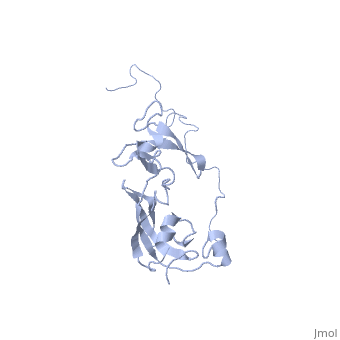2kfw
From Proteopedia
(Difference between revisions)
| Line 3: | Line 3: | ||
<StructureSection load='2kfw' size='340' side='right'caption='[[2kfw]], [[NMR_Ensembles_of_Models | 20 NMR models]]' scene=''> | <StructureSection load='2kfw' size='340' side='right'caption='[[2kfw]], [[NMR_Ensembles_of_Models | 20 NMR models]]' scene=''> | ||
== Structural highlights == | == Structural highlights == | ||
| - | <table><tr><td colspan='2'>[[2kfw]] is a 1 chain structure with sequence from [ | + | <table><tr><td colspan='2'>[[2kfw]] is a 1 chain structure with sequence from [https://en.wikipedia.org/wiki/"bacillus_coli"_migula_1895 "bacillus coli" migula 1895]. Full experimental information is available from [http://oca.weizmann.ac.il/oca-bin/ocashort?id=2KFW OCA]. For a <b>guided tour on the structure components</b> use [https://proteopedia.org/fgij/fg.htm?mol=2KFW FirstGlance]. <br> |
| - | </td></tr><tr id='gene'><td class="sblockLbl"><b>[[Gene|Gene:]]</b></td><td class="sblockDat">slyD, b3349, JW3311 ([ | + | </td></tr><tr id='gene'><td class="sblockLbl"><b>[[Gene|Gene:]]</b></td><td class="sblockDat">slyD, b3349, JW3311 ([https://www.ncbi.nlm.nih.gov/Taxonomy/Browser/wwwtax.cgi?mode=Info&srchmode=5&id=562 "Bacillus coli" Migula 1895])</td></tr> |
| - | <tr id='activity'><td class="sblockLbl"><b>Activity:</b></td><td class="sblockDat"><span class='plainlinks'>[ | + | <tr id='activity'><td class="sblockLbl"><b>Activity:</b></td><td class="sblockDat"><span class='plainlinks'>[https://en.wikipedia.org/wiki/Peptidylprolyl_isomerase Peptidylprolyl isomerase], with EC number [https://www.brenda-enzymes.info/php/result_flat.php4?ecno=5.2.1.8 5.2.1.8] </span></td></tr> |
| - | <tr id='resources'><td class="sblockLbl"><b>Resources:</b></td><td class="sblockDat"><span class='plainlinks'>[ | + | <tr id='resources'><td class="sblockLbl"><b>Resources:</b></td><td class="sblockDat"><span class='plainlinks'>[https://proteopedia.org/fgij/fg.htm?mol=2kfw FirstGlance], [http://oca.weizmann.ac.il/oca-bin/ocaids?id=2kfw OCA], [https://pdbe.org/2kfw PDBe], [https://www.rcsb.org/pdb/explore.do?structureId=2kfw RCSB], [https://www.ebi.ac.uk/pdbsum/2kfw PDBsum], [https://prosat.h-its.org/prosat/prosatexe?pdbcode=2kfw ProSAT]</span></td></tr> |
</table> | </table> | ||
== Function == | == Function == | ||
| - | [[ | + | [[https://www.uniprot.org/uniprot/SLYD_ECOLI SLYD_ECOLI]] Folding helper with both chaperone and peptidyl-prolyl cis-trans isomerase (PPIase) activities. Chaperone activity prevents aggregation of unfolded or partially folded proteins and promotes their correct folding. PPIases catalyze the cis-trans isomerization of Xaa-Pro bonds of peptides, which accelerates slow steps of protein folding and thus shortens the lifetime of intermediates. Both strategies lower the concentration of intermediates and increase the productivity and yield of the folding reaction. SlyD could be involved in Tat-dependent translocation, by binding to the Tat-type signal of folded proteins. The PPIase substrate specificity, carried out with synthetic peptides of the 'suc-Ala-Xaa-Pro-Phe-4NA' type (where Xaa is the AA tested), was found to be Phe > Ala > Leu.<ref>PMID:12100551</ref> <ref>PMID:15569666</ref> <ref>PMID:16388577</ref> <ref>PMID:17720786</ref> <ref>PMID:17215254</ref> <ref>PMID:19356587</ref> Required for lysis of phiX174 infected cells by stabilizing the hydrophobic viral lysis protein E and allowing it to accumulate to the levels required to exert its lytic effect. May act by a chaperone-like mechanism.<ref>PMID:12100551</ref> <ref>PMID:15569666</ref> <ref>PMID:16388577</ref> <ref>PMID:17720786</ref> <ref>PMID:17215254</ref> <ref>PMID:19356587</ref> Also involved in hydrogenase metallocenter assembly, probably by participating in the nickel insertion step. This function in hydrogenase biosynthesis requires chaperone activity and the presence of the metal-binding domain, but not PPIase activity.<ref>PMID:12100551</ref> <ref>PMID:15569666</ref> <ref>PMID:16388577</ref> <ref>PMID:17720786</ref> <ref>PMID:17215254</ref> <ref>PMID:19356587</ref> |
== Evolutionary Conservation == | == Evolutionary Conservation == | ||
[[Image:Consurf_key_small.gif|200px|right]] | [[Image:Consurf_key_small.gif|200px|right]] | ||
| Line 32: | Line 32: | ||
==See Also== | ==See Also== | ||
*[[Peptidyl-prolyl cis-trans isomerase 3D structures|Peptidyl-prolyl cis-trans isomerase 3D structures]] | *[[Peptidyl-prolyl cis-trans isomerase 3D structures|Peptidyl-prolyl cis-trans isomerase 3D structures]] | ||
| - | *[[The Escherichia coli sensitive to lysis D (SlyD) protein|The Escherichia coli sensitive to lysis D (SlyD) protein]] | ||
== References == | == References == | ||
<references/> | <references/> | ||
Revision as of 07:04, 1 December 2021
Solution structure of full-length SlyD from E.coli
| |||||||||||
Categories: Bacillus coli migula 1895 | Large Structures | Peptidylprolyl isomerase | Conte, M R | Giancola, C | Hands-Taylor, K L | He, Y | Kelly, G | Martino, L | Valentine, E R | Cobalt | Copper | Cytoplasm | Isomerase | Metal-binding | Nickel | Protein | Rotamase | Slyd | Zinc


